By Don Malkowski
Here some great tips to help you catch more Striper or Rockfish on the Chesapeake Bay.
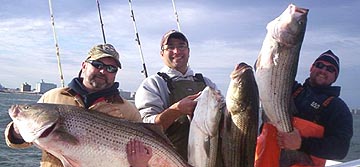
WHAT: It doesn’t matter what you call it, Striped Bass, Rockfish, Linesider, True Bass, or Striper, it’s probably the most sought after near shore species on the East coast from the Carolinas north to New England. Morone saxatilis, as its known in the scientific world, excites anglers with a deep seeded passion. They are singled out by so many anglers because you can catch them from nearly any platform. Whether you fish from a canoe, a 74’ Viking, walk the numerous local piers, or keep your feet in the sand along the surf, you have the opportunity to land stripers. That’s the great allure of this fish.
Stripers inhabit bays, rivers, and the coastal regions along the Western Atlantic. They migrate along the coastline and breed in the rivers during the spring. Stripers are distinguished by the 7-8 dark stripes that extend horizontally along its body. It has an olive to steely blue or gray back with a white belly. A large mouth is suited for eating anything from clams, eels, and small bait fish to trout and flounders. Menhaden, or Bunker as it is called on occasion, is the primary forage for migrating Stripers, but Sand eels and other bait will also feed their appetites. The oldest recorded age for a Striper is approximately 30 years old. Males can reach lengths of 45 inches, while females can top out well over 70 inches. Striper can range vastly in weight, depending on the time of year. A 45 inch fish caught in the beginning of a migration can weigh as little as 28-30 pounds, where as the same fish caught just a few months later can top the scales near 50 pounds. This is due to their voracious eating habits pre-spawn. The IGFA World Record holds at 78 pounds 8 oz, but the largest Striper ever caught weighed in at 125 pounds.
After a near catastrophic decline in the Striper population in the early 80’s from over fishing, strong regulatory action was set in place to protect the species. The Federal Government closed its waters out past 3 miles to Striper fishing and States put restrictions on size and bag limits to help replenish the stock. Current Virginia regulations can be found at VMRC’s (Virginia Marine Resources Commission) website, http://www.mrc.state.va.us.

WHEN & WHERE: Due to their migratory patterns, the “When” and “Where” depend on the time of year and water temperatures. Striper can be had nearly year round; however, the big seasons locally along the Mid-Atlantic are spring and fall/winter. Stripers like to hang around in rocky areas (giving them one of their names, Rockfish) and structure with strong currents where they lie in wait for a passing meal. They also can favor rips, the mouths of rivers and inlets, or the holes along the surf zone.
Stripers are comfortable in waters ranging from the low 40’s up to 70 plus degrees. The different water temps will dictate where and how you fish for them. As I said earlier, Stripers are migratory fish, leaving their spawning grounds in the Spring and most heading north, only to return south in the Fall and Winter months as the temperatures drop, forcing bait to move south to warmer waters. Many studies are being conducted to determine if all fish migrate, and also if the fish return to the same spawning grounds as the previous year. Many juvenile fish will stay in the bays and rivers until large enough to make the ocean migration, usually once they reach 24-28 inches.
Spring will see more fish entering the bays and rivers as they find comfortable and safe spawning grounds. So for the Chesapeake Bay area, any of the Bay Bridge complexes, the middle bay, inlets, or mouths of rivers are prime areas to target trophy fish. During the Fall, the fish will leave the rivers and bays and head out into the open ocean feeding on large schools of bait preparing for their migrations south. The same areas will produce fish in early fall. Several local hot spots include the Hampton Roads Bridge Tunnel, the Chesapeake Bay Bridge Tunnel, James River, 9 foot Shoals, High Rise Bridge, Plantation Light, the buoys along the northern shipping channel of the Chesapeake Bay, the Cell, and any of the numerous tributary river mouths.
As water temperatures drop even more, into the low 50’s and cooler, most the fish will begin to move out of the bay and into the open ocean. Some fish migrating from northern areas will duck into the bay for a “Pit spot” before heading further south. Once in the ocean, the fish can be right along the shore or further out in deeper waters. This is primarily determined by the location of bait.
Another big determinant to Striper fishing is weather. You may be close to shore, but the colder water temps make it extremely dangerous to mess around with unnerving sea conditions. VBSF.net sponsor Capt Scott Sinclair of “On Course Custom Charters “ believes in this strongly and does his homework to ensure a safe return from a great day of fishing. “Weather is everything; it sets the standards for fishing. Weather determines if we stay in or go out. There are many sites to choose from to get your weather forecast. Choose these sites and then compare them. However, a barometer is a must. Rapidly falling pressure is a danger sign for mariners. Building pressure is a plus for fisherman. I watch the barometer carefully.”
HOW: Techniques to catching stripers are nearly as numerous as the fish themselves. Surf casting, live baiting, flies, jigging, trolling, and chunking are just a few. Each technique is determined by the time of year and location of the fish. So I’m going to break the “How” section down into seasons and touch on different tactics for each.
Early fall/spring: Early fall and spring can combine together since the fish will be found in nearly the same locations. The only difference is whether they’re coming or going. This is the time when water temps can be in the upper 50’s to mid 60’s. Working any of the bridges that span the bay, bottom contours/structure, inlets and rivers are good areas to start. Here’s how to get ‘em…
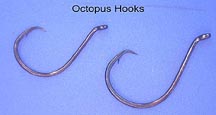
Live Baiting. Menhaden, Spot and Eels top the list of entrees on a Striper’s menu. Menhaden and Spot are primarily used while casting to the rock islands around the tunnel entrances. Casting the live bait right into the rocks and letting the bait work is the ticket. The Stripers bed in the rocks just waiting for baitfish to be washed into their strike zone by the waves breaking on the islands. Simply add a length of mono or fluorocarbon leader to your main fishing line. I like 30-40 pound test since you’re fishing around the rocks. Then add a live-bait hook or circle hook, usually around 6/0-8/0 depending on the size of your bait. Here I like the Gamakatsu Circle Octopus hooks or a Mustad Live-Bait O’Shaughnessy #94151. Hook the bait either under the chin threw the top of the nose, in the shoulder just in front of the dorsal fin, or threw the tail.
You can also use live baitfish when dropping the pilings, but here I prefer to use eels. Eels are nasty little critters that can take some getting use to. First tip when fishing with these slimy baits is to put them on ice. Take a bucket and drill a few small holes in the bottom to allow the melting ice water to drain out. Put a layer of ice in the bucket. Place the eels over the ice. The ice will put them in a state of hibernation. This makes it much easier to pick them up and put them on the hook. Once the eel hit’s the water it will come back to life and start squirming around. I like to use the Octopus hooks in this application as well, again in 6/0-8/0. You can either use a standard 3-way bottom rig with a dropper loop for your sinker, and 3-4 feet of 30-40 pound mono or fluorocarbon attached to your hook, or a fish-finder rig. If drifting I like the 3-way rig and if anchored or casting from shore, I like the fish-finder. Hook the eel behind its gills, or threw its tail. Eels have a tendency to ball themselves up in a knot. When they do this, they can easily put knots in your leader. They are the only marine animal I know that can tie a Bimini Twist. Hooking them in the tail helps prevent this and also forces the eel to swim away from your fishing line.
Once you’ve got the eel on the hook drop it over and hold on. Eels are known as “Striper Candy”. Stripers have a hard time passing them up. Drop the eels along the pilings, next to the rocks, or drift them over the tubes or bottom structure.
You can also use floats to suspend eels at different depths. Here you’ll tie a length of leader onto your main line like you would if using baitfish. Attach hook and some splitshot to add just enough weight to keep the eel below the float. Attach the float up your main line at a desired depth and float it back. This is very effective for suspended fish, and as an additional bait if anchored on the chunk.
Top Water/ Subsurface. Top Water action is probably the most exciting since you see the strike. This technique is utilized when the water temps are on the warmer end of the scale. This is because the fish are readily found closer to the surface and more active. Whether fishing at night or during the day, throwing a top water bait will drive Stripers nuts. Again, I’ll be fishing along the rock islands of the tunnel entrances. If fishing at night, I’ll be working the light lines and shadows under the spans. Night fishing in the fall can find the Stripers stacked up right on the surface like cordwood. Here lures like MirrOlure “Top Dog”, “Catch 2000”, chuggers, poppers, lipped crank baits, bucktails and Storm lures are the arsenal of choice. If on the rocks at the islands, cast the lure right into the rocks. Work the side of the island with the most wave action and let the crashing waves wash the lure into the rocks. Start to work the bait away for the islands and work it all the way to the boat. Sometimes you can have a fish following a bait for a while before striking. Once you see a 34 inch bucket mouth crash a top water plug, you’ll know why its one of the favorite techniques among anglers.
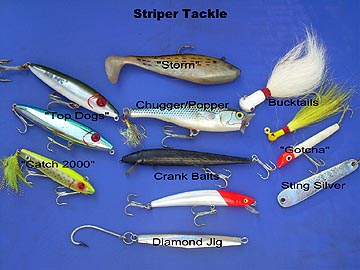
Jigging. Bucktails have been used to land big Stripers for years and are still very effective today. Either tipped with cut squid or with artificial rubber curly tails, bucktails are a must in a Striper tackle box. Work these baits right along side the pilings of the spans, jig them over the tubes, or drop them in the rocks. To get the most out of the bait, drop it down then “Jig” it up and let it fall again. Repeat for a while and then try different depths if no takers. Stripers are opportunistic feeders. Since they have flat tails, they don’t have the speed advantaged like their forked tailed cousins. Therefore, many times the fish will hit the baits on the slow freefall. This is a time when braided line can come into play. Since braid line has little to zero stretch, you can feel the fish hit the bait and you’ll also be able to set the hook with more authority.
Other jigging baits include Diamond jigs, Hopkins spoons, heavier Storm Lures or Gotcha Plugs.
Trolling. Most of the trolling during the Spring and early Fall is concentrated around the bridge spans and tunnels, but can also be taken to the open areas around the bay’s shipping channels and river mouths. Due to the close proximity to other boats and the bridges themselves, certain techniques have been adapted to make the best of the situation. Wire-lining is the go to method next to the pilings and over the tubes. Here anglers will have conventional reels spooled with braided wire. This allows the baits to be pulled straight down directly behind the boat without the bow-back you would get from the standard stretchy mono. With the creation of the new high-performance braided lines, many are switching over from wire. Braided lines give you similar results and are easier to work with.
The basic trolling rig is a standard 3-way bottom rig on steroids. Take a heavy duty 3-way swivel. On the bottom swivel, tie a 3-5 foot length of mono. This is for your sinker. Here I’ll use 20 pound test. There are many obstructions along the bridge span, so having a light leader will allow you to beak off the sinker without loosing the “money” part of the rig. You can attach a snap swivel for ease of sinker changes if you wish. Off the top part of the swivel, I’ll attach at least 15 feet, sometimes up to 25 feet of 40-50 pound mono or fluorocarbon. It’s not uncommon for me to use even heavier mono, 60-80 pounds. This is not so much for the fish, but for me. If the bite is hot, you may have several fish on at once, with only one net. This allows you to be able to hoist the Striper into the boat if the net is being used on another fish on the other side of the boat. To the end of the mono or fluoro, I attach a snap swivel. Again this aids in quick changes of lures. For trolling the spans, I like Storm Lures, small bucktails (by themselves or with a curly tail), Tomics, or Crippled Alewives Spoons. You can also slow troll live eels off this rig. Just replace the snap swivel with a hook.
Noticed I said slow trolling. Trolling speed for Stripers is normally under 4 knots on the high end. Usually I like 2-2.5 knots. Remember, Stripers have a broad tale, limiting their speed. Presenting them a slow bait in their strike range is key. When trolling along the pilings, drop your rig down and let the sinker hit bottom. You’ll be using between 20-28 oz of lead, so you’ll know when you hit. Now bridge trolling is not a set it and forget it spread. Because of all the obstacles and debris on the bottom and the depth changes, an angler has to man the rod and continually “bounce” the bottom. Lift the rod up and let it drop back down until you feel bottom. If you don’t feel bottom, let some line out. If you feel bottom before completing a full range of rod motion, reel in some line. This will help dramatically against hang ups on the bottom. This technique is also used when trolling over the tubes. The channels are shaped like a bowl, shallow on the edges and deeper in the middle. You want to start your troll on the shallow edge and work deeper, bouncing the bottom all the way to the deepest part of the channel. Once you start coming up the other shallower side, pull your lines up and motor around to your starting point. Bouncing bottom when trolling into the shallower water can still cause many hang-ups on the rocky bottom. It is likely there will be several boats trolling the same confined area. Getting hung-up will cause backups with fellow boats and that’s when our worst manners come out. Also when approaching a tube or span, slow down and look to see what direction others are trolling and fall into their pattern. This eliminates opposing trolls and those bad manners I eluded too. This is just one of the common courtesies of Striper fishing.

Now what side do you troll on? Always troll on the up current side of the piling or tube. This is where your long leaders on the 3-ways come into play. The current will swing your baits into the pilings and over the tubes where the fish are holding. If you fish the down current side, your baits will be far away from the target zone. Longer leaders will allow your baits to swim further into the zone.
You can also troll Stretch 15’s or 25’s along with Storm lures, bucktails, spoons, or live eels on 3 to 4 oz inline sinkers. A minimal spread is better while working the bridges; may be 4 lines. It makes it faster to retrieve if you get hung up, plus the increased boat population can make for some tight quarters.
A tip about using spoons on a 3-way rig. Tie a barrel swivel about 3-5 feet up from the spoon. This will help with line twist in the long leader.
Chunking. Chunking is a relatively new fishing technique for catching Stripers, but highly effective. Stripers tend to hold not only on physical structure like rocks and piling, but also the perceived structure of bottom contours, like drop-offs and shoals. This is where Chunkers will anchor up and set baits. Anchoring on the shallows and letting baits drift over the deeper contours is the main goal. The preferred bait for chunking is fresh menhaden. Tackle shops like Long Bay Pointe Bait and Tackle carry both fresh and frozen menhaden. If possible, netting some live menhaden or spot can add some extra spice to your chunking spread.
Basically, after setting anchor, chunks of bait are tossed out creating a slick and a boulevard of bait that leads the fish to the boat. You can also add a slow drip of menhaden oil for added attractant. The spread will consist of baits, both chunks and live baitfish or eels set at different depths from the bottom to the surface. Fish-finder rigs are great in this application. Close to the boat, you’ll have your deep baits. Vary your sinker weights as to stagger the baits away from the boat. Next you’ll float out chunks or eels on large floats. You also want to vary the depths these are fished. Toss out enough chunk to act as appetizers for the fish, not a four course meal. You want them to entice the fish, not feed them. Once you have fish in the slick, casting top water lures or swimming crank baits can add to the fun.
Surf/Pier. Casting Bucktails, Storms, Sting Slivers, or natural baiting with eels, spot, or cut bait, will put you on the fish from the boards or the suds. Lures are easily presented by tying directly to a mainline or a length of leader. The live baits and cut baits can be rigged on standard bottom rigs or fish finder rigs. Many times the Stripers can be found right in the surf zone. Try to find and fish the areas between the beach and a sandbar. Bait will get washed into this sloop at high tide and can get trapped. Stripers will hold on the ends of the sandbars waiting for the bait to come by. Look for areas of rip current activity. Cast to these areas and allow your baits to be taken out. Fish can also hold on the back side of the bars. For cut baits and live baits, pyramid sinkers are used primarily for stationary baits, while bank sinkers work well if you want you baits to move with the currents along the beach.

Late Fall/ Winter: This is the time when large fish are moving down the coast and boats start heading out to the ocean to troll for the big cows. Here our spreads will increase in size and also the diversity of baits. Many of the techniques discussed here can be carried into the open bay trolling as well. This section will be directed towards the Virginia Coastal Season regulations. I called in some experienced captains for some additional advice for finding big Stripers, Capt Scott, “On Course Charters” and Capt. Dave Wessner of “Billable Ours”.
First thing we need to cover is where you can fish. The Federal waters beyond 3 miles from shore are closed to both fishing for Stripers and processing Stripers. The Virginia Marine Resources Commission has a chart outlining the demarcation line between the bay and the ocean (link provided below). The line extends from Cape Henry in Virginia Beach to Cape Charles light on the Eastern Shore. These are important lines to know because fishing outside of them can bring hefty fines. Fishing inside the Cape Henry/Cape Charles demarcation line you have a different set of size limits. Coastal limits are Striper are 28 inches or larger and 2 per person. Therefore, some of the fish you catch in the ocean, would be illegal in the bay. And fishing outside the 3 mile line will present you with a Federal citation and some substantial fines.
Okay, enough with the legal talk…lets get to fishing. An ocean trolling spread is going to be designed to cover the water column vertically. Stripers can hold at different depths depending on the location of bait. Capt Dave Wessner, likes a staggered spread. “We usually keep a lure spread staggered in depth to target fish throughout the water column, even though many fish may be feeding on bait near the top. Larger fish will often stay deeper and hit your bigger baits. A typical Striper spread starts of with my long baits. These are the baits furthest away from the boat and will have the tendency to be higher in the water column. Here I’ll normally run inline trolling weights tied to a length of 10-15 feet of 80 pound mono with a snap swivel attached at the end. My baits will consist of 6’ or 9” Storm lures, artificial eels (or live eels), larger bucktails (approx. 2-3 oz), Crippled Alewife Spoons, or a Tomic lure. The snap swivel again allows me to change things out quickly. I may run and inline combo on each side of the boat, or I may put a Stretch 25 in its place. Sometimes if conditions allow, I’ll run a Stretch right down the middle of the spread in a Shotgun position with inline rigs in the long positions. The Shotgun may also be swapped out for a solo spoon. Stretches are great for big Stripers. They add both noise and vibrations that Capt Scott Sinclair feels is crucial for landing big fish. “Water carries sound waves better than air, so let’s use it to our advantage. Our lures need to make noise. The more noise the better. It doesn’t matter whether it’s a chug, rattle or spit. It must talk.”
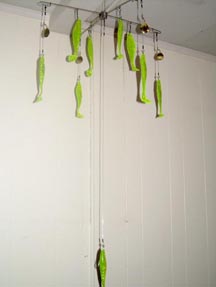
The next baits that hit the water are umbrella rigs. These puppies can be a mate’s worse nightmare, but you won’t hear any complaining when there’s a 44 inch Striper in the net. An umbrella is designed to mimic a bait ball, which is what a spread is trying to do as well. Umbrellas can vary from small 10” 4 arms to larger 32” 6 arms. Baits are hung across the arms at varying distances. Some are hooked baits and some are teaser baits. Then down the center is a hooked stinger bait any where from a foot to 2 feet from the “bait ball”. In Virginia, you’re allowed to have multiple hooks. Maryland only allows 2 hooks per bait, rig or lure. Umbrellas can be run by themselves, if heavy enough to stay under the surface, or with an inline trolling sinker. If you use a trolling sinker, you can run them one of two ways. First is by attaching the sinker directly to the umbrella rig using a snap swivel and split rig. Some trolling sinkers come with pre-attached snap swivels, but if yours doesn’t its and easy fix. Simply attach a heavy duty split rig to one end of the trolling sinker and then add a snap swivel. The second convention is to have a length of leader in between the sinker and the umbrella. Here you would attach approximately 4-6 feet of mono to you umbrella and the sinker. This keeps the weight away for the umbrella. Either way, the goal is to set the umbrella at a desired depth…in front of the fish’s nose.
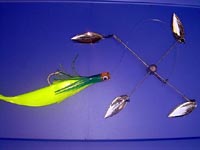
Umbrellas come in different styles. Some are all shad bodies, or surgical tubing, or curly tails. One tip that Capt Scott has let out of the bag is the importance of flash. He likes to add Colorado blades to his umbrellas. “Light and reflection is everything. Colorado blades are a must when trying to catch the eye of a trophy. The flutter thru the water along with the reflection, will entice them to strike. It’s a natural reaction.” This small feature can mean the difference between watching the winners at a tourney and being the tourney winners.
Last comes the deep, bottom-bouncing baits. Here I run a beefed up 3-way rig like the one we use in the bay. Instead of using 20 pound mono on the shorter bottom swivel, I’ll bump it up to 80-100 pound. Out in the ocean I’ll be pulling a Mojo instead of just ad heavy sinker. Mojos have to be one of the most unnatural looking baits on the market, but they are one of the most effective at catching big Stripers. In essence it’s a very large bucktail, anywhere from 16 oz up to 64 oz.

The Mojos are hooked with large shad bodies giving you an extra bait to snag a Striper. With less obstruction off the coast as opposed to the bridge areas, pulling a Mojo is much easier. Off the top of the 3-way, I’ll run similar baits as the inline rigs, Storm lures, artificial eels (or live eels), larger bucktails , Crippled Alewife Spoons, or a Tomic lure. There have been many times when we’ve caught fish on both the Mojo and the trailing bait. Make sure you match your rod and reels to the heavier rigs you’re pulling. I usually have 2 Mojo rigs out at a time. Make sure if you do the same that the Mojos are of two different weights. This will stagger their distance behind the boat and lessen the chance of tangling during turns.
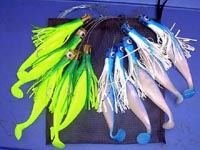
Sometimes I will replace a Mojo rig for a Daisy Chain set up. This is not a horizontal chain like you would run offshore. By attaching a Mojo at the bottom, the daisy chain covers the water column vertically. A chain typically consists of 5-6 baits, frequently shad bodies combined with Shooters or bucktails. These will help you find the fish, both at the bottom or those holding mid-level.
Now lets talk about some colors of lures. There’s an old saying, “It ain’t no use, if it ain’t chartreuse!” and boy does that hold true. Chartreuse is one of the top color choices anglers go to when buying Striper tackle. Its bright and makes for a fine target for Stripers. A close second is a red and white combination. Other colors are blue and whites, black, “ghost” gray, silver, gold, and the natural bunker and shad colors. Capt Scott states, “Dark cloudy days, means darker lures. Light days, blue bird sky’s I use lighter colors. I try to make the spread as visually appealing as possible.” That’s very similar to those freshwater fishing for largemouth bass.
Trolling speeds out here in the ocean are the same as in the bay…slow and steady. Remember, Striper are not fast fish, and the cooler the water temps, the slower they move. If they can’t get to your spread, you can’t get them in the boat. Capt Dave Wessner agrees with this. “Around 2-3 knots is the preferred Striper trolling speed. Watch your combined current, drift and boat speed to try and stay in that range.” Some larger boats have a hard time going that slow, so running on one engine or even bumping in and out of gear will aid in keeping the boat speed down. I’ve even seen some boats pulling buckets behind them to slow them down. Capt Scott and Capt. Dave both agree the main goal is to keep the action of the lures as natural as possible. Presentation is everything. With strong currents and winds, you may find yourself adjusting speeds with each turn.
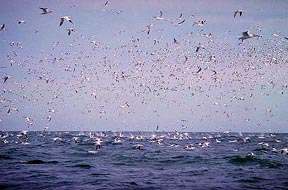
So what do you look for while trolling in the ocean since there are no bridges or rock piles sticking out of the water? You look for birds and schools of bait on your fish finder. Gannets are a key size to finding the bait. These are large white birds with black tips on their wings. If you see them “working”, diving into the water, there’s a great chance a school of bait is below them. And where there’s bait, the fish should be close by. Slowly troll towards the working birds and work the outer edges of the bait school. This is where the larger fish will hang out. One thing you should never do is run full steam into a school of bait and birds. This is the quickest way to split the bait and drive the fish away. Plus it will greatly increase the amount of enemies you just made on the water. Both captains agree. Capt Scott reminds us, “If you are first to the beehive, don’t barrel thru the middle. Try the outsides first; attempt to circle the bait balls, just like the natural predators do. Occasionally getting closer, you’ll find the fish you are targeting.” “For us,” says Capt. Dave, “the basic rules are Bait and Birds. While a “beehive” of sea birds is a sure sign that bait has been pushed to the surface, it is also a sign that any boat within sight will be running towards it to try and catch fish. If you’re lucky enough to be first or alone, you can work the edges and pull fish off of the bait.”
Something else I want to touch on is radio chatter. Sometimes during Striper season the radio can be a blaze with reports or lack there of. Try not to become a slave to the radio. There are many out there that give true reports of fish, BUT there are just as many that will lead radio listeners on wild goose chases away from the actual bite. If you’re marking bait and have had strikes, or even better caught fish, don’t be so fast to pull lines and head off to another location that you heard about on the radio. Like Capt Dave says, “If you have taken a fish or two from a location but the bite slowed down, expand your pattern a little and work the marks. The bite can turn back on again with the larger fish taking their turn.” Learn from the tips we’ve laid out here and learn to find the fish yourself.
These are a little more than the basics of Striper fishing, but still far from every trick known to anglers. The best advice, as with any fishing, is to try out some new things and find out what works best for you and your style of fishing. Take ideas and adapt them to fit you. None of this is written in stone and these surly aren’t the only ways to catch big fish, but they will get you on the path to landing big cow Stripers.


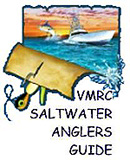
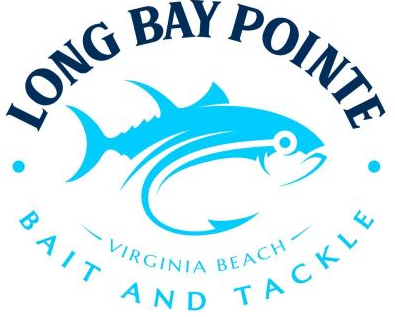







 Views Last 7 days : 1843
Views Last 7 days : 1843 Views Last 30 days : 8759
Views Last 30 days : 8759